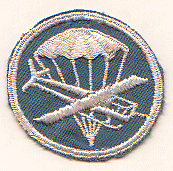 Sixty-six years ago, a bunch of braver-than-me guy strapped themselves into a bunch of balsa-wood air-frames and nose-dived into Nazi-occupied Europe in gliders that supported the airborne invasion of the continent.
Sixty-six years ago, a bunch of braver-than-me guy strapped themselves into a bunch of balsa-wood air-frames and nose-dived into Nazi-occupied Europe in gliders that supported the airborne invasion of the continent.Robert Herriot's sister Evelyn sent him a four-leaf clover while he was stationed in England during World War II.
It was in his uniform chest pocket as he sat on a bench in a plywood glider in the skies over Holland on Sept. 17, 1944, one of many sent to take the bridges and countryside from the Germans. As it was towed behind a C-47 plane, the pilot and co-pilot pulled a lever to sever the tie between the large cargo plane and the engineless glider. As the aircraft glided earthward, it almost immediately came under heavy anti-aircraft attack.
About 100 feet from the ground, the pilot and co-pilot slumped over dead from shrapnel piercing upward through the flimsy fuselage. Herriot had never been in a glider before and didn't know how to fly one, but he happened to be the guy sitting right behind the pilot.
"I pushed the pilot out of the way and got in his seat," Herriot, 90, of Friendship, recalled Thursday afternoon. "I went through a barbed wire fence and ended nose up in a ditch. I think that saved us from enemy fire."
Herriot and the dozen other soldiers in the back of the glider survived unscathed, and he earned a Bronze Star a short time later for taking over his platoon and leading them across a bridge while under fire.
Herriot and about 80 other World War II glider pilots and riders are in Madison for a three-day symposium on the relatively little-known aircraft that made a huge difference in a half dozen combat operations in Europe, including D-Day and Operation Market Garden. The symposium continues Friday and ends Saturday.
Thursday's event was held at the U.S. Forest Products Lab in Madison because of the connection of Wisconsin's forests to the Army's Glider Corps. Plywood from Roddis Lumber and Veneer in Marshfield was sent to eight of the 16 wartime glider manufacturers, so it's quite possible that Herriot journeyed thousands of miles from his central Wisconsin home to fly a plane made from wood logged not far from where he grew up.
h/t to Dan for sharing this article...
By: Brant

No comments:
Post a Comment